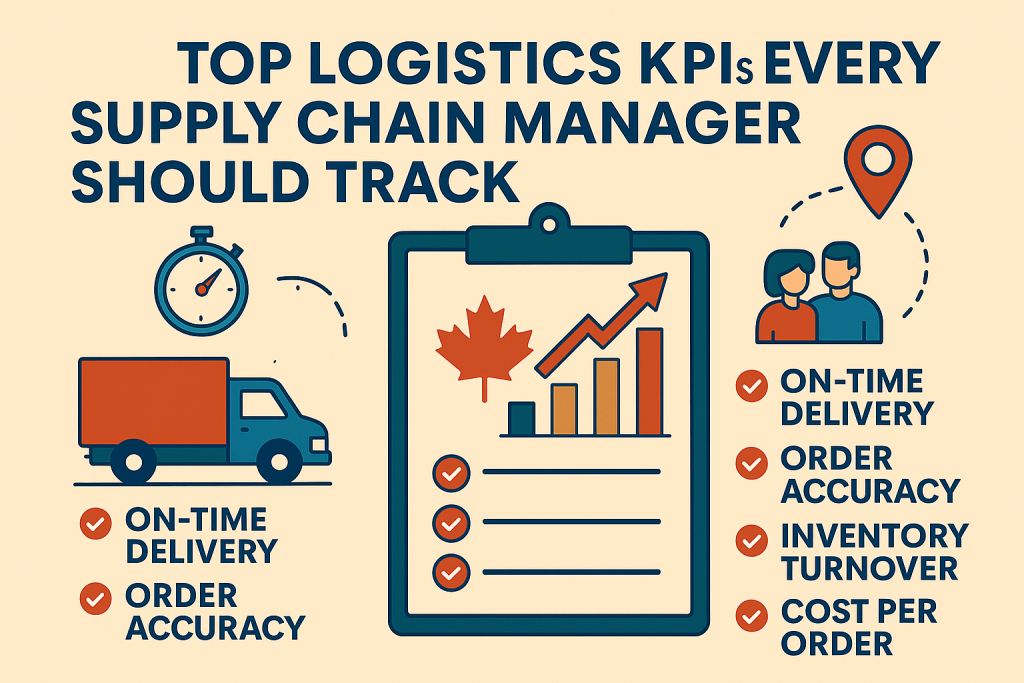By Martin Vassilev / 11 Aug, 2025

In today’s hyper-competitive marketplace, supply chain efficiency is no longer just an operational goal — it is a strategic imperative. For supply chain managers, tracking the right Key Performance Indicators (KPIs) can mean the difference between seamless operations and costly inefficiencies. From inventory accuracy to delivery performance, KPIs provide data-driven insights that allow managers to streamline processes, enhance customer satisfaction, and optimize costs.
This comprehensive guide explores the most critical logistics KPIs that every supply chain leader should monitor, why they matter, and how to apply them effectively.
Logistics KPIs serve as measurable benchmarks that align operational activities with strategic business goals. They enable managers to:
Identify inefficiencies in warehouse operations, transportation, and order fulfillment.
Measure customer satisfaction by tracking delivery speed, accuracy, and reliability.
Support data-driven decision-making to reduce costs and improve service levels.
Forecast and plan capacity based on demand trends and historical performance.
For a deeper understanding of how KPIs integrate into overall supply chain strategy, see our guide on Optimizing Your Supply Chain for Global Challenges.
The percentage of orders delivered to customers on or before the promised delivery date.
High OTD rates signal reliability, which strengthens customer trust. In industries where timing is critical, even minor delays can result in lost sales and damaged brand reputation.
Implement real-time tracking systems like those discussed in Real-Time Warehouse Tracking Systems.
Optimize route planning using AI-powered logistics platforms.
Maintain accurate inventory levels to avoid fulfillment delays.
The percentage of orders shipped without errors in quantity, product type, or destination.
Order accuracy directly affects customer satisfaction and return rates. Even a single incorrect shipment can incur high reverse logistics costs.
Integrate automated scanning and verification technologies.
Conduct periodic inventory audits to prevent discrepancies.
Train staff on standard operating procedures for picking and packing.
The number of times inventory is sold and replaced over a specific period.
A high turnover ratio indicates efficient inventory management and strong product demand. Low turnover suggests overstocking or slow-moving products, which tie up capital.
Use data analytics for demand forecasting, as detailed in How to Leverage Data Analytics for Streamlined Inventory Management.
Implement just-in-time (JIT) replenishment systems.
Regularly review product performance and adjust purchasing cycles.
The average transportation cost incurred per unit of product shipped.
Transportation is often one of the largest expenses in logistics. Monitoring this KPI ensures competitive shipping rates and cost-efficient routing.
Consolidate shipments to maximize load efficiency.
Negotiate carrier contracts for better rates.
Apply dynamic routing software to minimize distance and fuel consumption.
The percentage of orders delivered without any issues — on time, complete, damage-free, and with accurate documentation.
This KPI is a holistic measure of supply chain effectiveness. It reflects the synchronization of all logistics processes.
Standardize processes across warehouse, transport, and customer service.
Integrate ERP systems for seamless data flow.
Use automated quality control checks at key fulfillment stages.
The total warehousing expenses divided by the number of orders processed.
This metric helps identify cost-saving opportunities in storage, labor, and handling. With warehousing costs rising globally, efficiency here can significantly improve margins.
Adopt lean warehousing principles (see Lean Warehousing Benefits).
Utilize vertical storage systems to maximize space.
Automate repetitive tasks to reduce labor dependency.
The ratio of freight claims (due to damage, loss, or delays) to total shipments.
A high claim rate signals problems in packaging, carrier selection, or handling processes.
Invest in robust packaging materials.
Partner with reliable carriers with proven track records.
Train staff in safe handling procedures.
The average time taken from order placement to final delivery.
Speed is a major competitive differentiator in modern logistics. Consumers and B2B buyers alike expect rapid fulfillment.
Offer multiple delivery options, including same-day service when viable.
Use strategically located distribution centers to minimize transit times.
Explore on-demand warehousing solutions for flexible capacity management.
The total time taken from the moment a customer places an order to when the product is delivered.
Shorter cycle times indicate a responsive, agile supply chain.
Map and streamline process flows.
Leverage automation in order processing and picking.
Build strong supplier relationships to reduce lead times.
The average CO₂ emissions generated per shipment.
Sustainability is now a critical performance metric, especially as governments and customers push for greener supply chains. Companies can reference resources like the U.S. Environmental Protection Agency’s Sustainable Supply Chain Guide to implement eco-friendly practices.
Adopt electric or hybrid delivery vehicles.
Optimize load utilization to reduce trips.
Implement reusable or biodegradable packaging.
To ensure logistics KPIs deliver actionable value:
Select KPIs aligned with business goals.
Invest in real-time data tracking tools for accuracy and immediacy.
Benchmark performance against industry standards.
Act on insights promptly to maintain continuous improvement.
For example, integrating KPI tracking into your warehouse automation strategy (explored in The Future of Warehouse Automation) can transform performance monitoring into proactive problem-solving.
Tracking the right logistics KPIs enables supply chain managers to make informed decisions, reduce operational costs, and exceed customer expectations. By monitoring metrics such as on-time delivery, order accuracy, inventory turnover, and carbon emissions, businesses can achieve a competitive advantage in both cost efficiency and service quality.
For tailored logistics solutions that prioritize KPI-driven results, contact ByExpress today and discover how our expertise can help you optimize your supply chain performance.

“Thanks to Byexpress all my shipping and fulfillment costs are in line now”

“All my issues were solved by Byexpress team that I had with pervious 3pl provider.”

“Thank you Byexpress team could not done it without you guys.”

“Their integration and customer service were the key for me”

“Outstanding delivery service! The package was well-packaged, and
the delivery team was professional and courteous”

“Great and knowledgeable team to work with.”

Thanks, guys, for reducing my shipping rates
Ottawa Office
2411 Holly Lane
Ottawa, ON, K1V 7P2
Toronto Office
13-280 West Beaver Creek Road Unit #136
Richmond Hill, ON, L4B 3Z1
Alexandria Office
173 Kenyon Street West
Alexandria, ON, K0C 1A0
Montreal Office
4388 Saint-Denis Street Unit #200
Montreal, QC, H2J 2L1
California Office
155 North Riverview Drive
Anaheim Hills, CA, 92808
Call Us
Toll-Free: 1-866-744-7122
Local : 613-739-3000
Email Us
Multilingual Services










